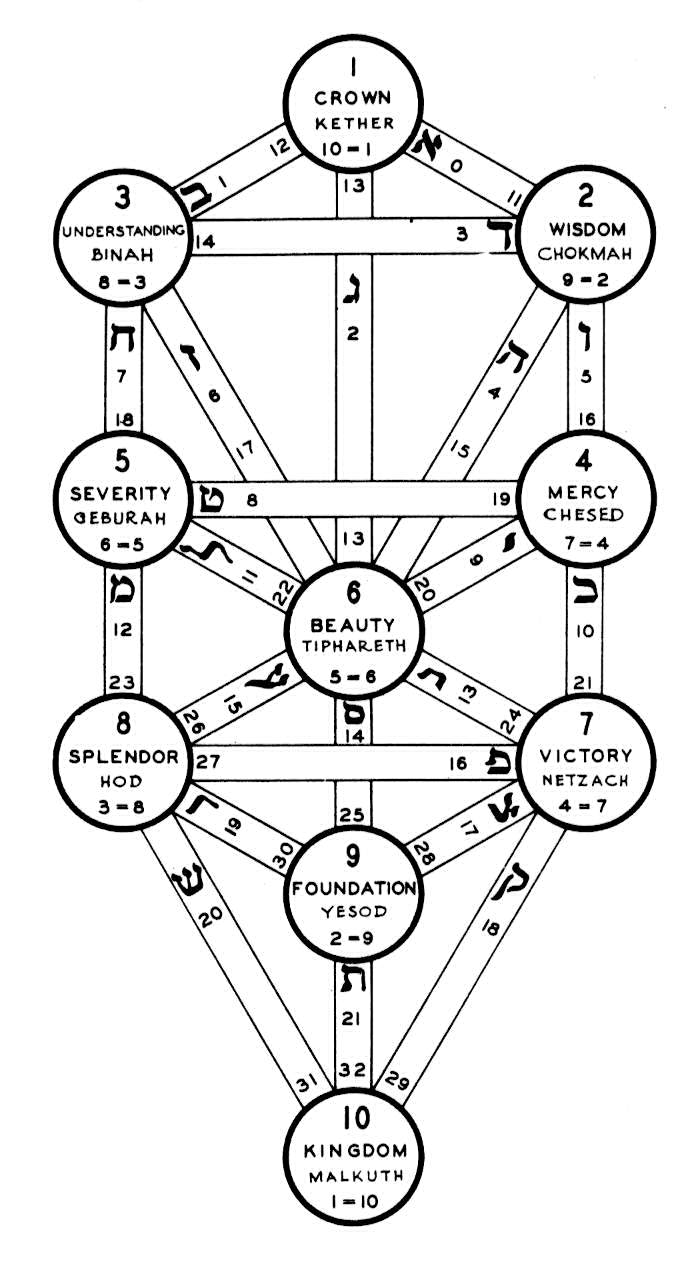
| rosanista.com | ||
| Simplified Scientific Christianity |
Samekh is the fifteenth letter of the Hebrew alphabet and its symbol resembles a serpent holding its tail in its mouth. It signifies the number 60. "In the letter Samekh," says the kabbalist, "is found the spirit of evil. Samekh is the first letter of the third-final series. In this series the power of the flesh-body and the human will are predominant." It is the ninth of the single letters.
The symbolism of the serpent with tail in mouth is one of the earliest developed. Christ Jesus said, "Be ye therefore wise as serpents, and harmless as doves;" a true Initiate admonition.
Again the kabbalist says, "Samekh is the great cosmic bow, the string of which hisses in the hands of the profane." The serpentine force in man exalts him to the highest estate where he knows himself to be a god or, on the contrary, degrades him to a state of animalism.
Astrologically, Samekh belongs to Sagittarius, sign of aspiration, idealism and attainment on physical, mental and spiritual planes. The pendulum swings in its full arc, from the heights to the lowest point and up again to the heights.
Physiologically, Samekh correlates with the lower spinal column and sacral plexus, whence the currents of the serpentine spirit fire ascend.
Numerologically fifteen, which is its place in the procession of letters, the 1+5=6, correlating again to the numeral value of 60. It is the sixth expression of the decad. All of the sephirothic powers express on each and every plane of being, and so the powers of 60 represent a sixth expression of the whole gamut of cosmic and egoic forces.
"Things which are seen are temporal," said one who knew, in regard to the transitional state. The Tarot picture shows the contrast between Aleph and Samekh, for Aleph is the White Fire of God expressing on the plane of eternity; Samekh is the Fire which burns in the sense world, with its constantly shifting and changing values, a plane of continuous transition. There are two Masters, one representing the forces of Light and the other the forces of Darkness. The first points the way to immortality by lifting the staff (the life current) toward the head (purity and regeneration). The second points the way to sense indulgence which leads to degeneration and death.
Man is free to choose his own path. "Le demon est Deus inversus."
It is perhaps significant that some kabbalists relate the sign X to this letter, which is occasionally written Xmach; and again Masonic legend suggests deep underlying mysteries.
A Masonic historian suggests that the path of blood traced out by the wounded Hiram Abiff, staggering from door to door of the Temple, actually describes an X-cross. We note further that X is the cross of St. Andrew, upon which he was crucified, and that he is the patron saint of Constantinople, having founded the first Christian church there. St. Andrew is the patron saint of Scotland also, where the Scottish Rite Masonry originated.
It is said that the banner of Constantine which bore the "flaming (red) cross" and the words, "In this sign conquer," may in reality have had the Greek Chi and Rho in an emblem; for the Greek Chi is an X, and together with Rho, R, forms the beginning of the name Christos.
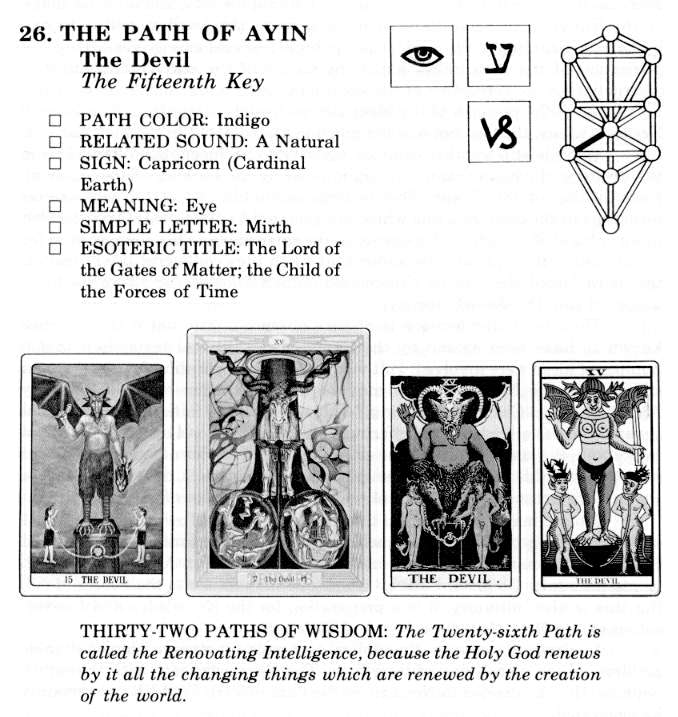

Ayin is the sixteenth letter of the Hebrew alphabet and tenth in order of the singles. 1+6=7. It is also the symbol for the number 70, the seventh plane of expression of the decad. Through the powers of 7 Ayin becomes a divine symbol.
Cosmically, it is the beginning of expanded consciousness. This letter aptly describes how man-though surrounded by upheavals and changes and caught in the swirl of suffering and disaster-is gradually but surely becoming conscious of a divine power that will aid him. The Bard of Avon had this awareness when he penned the lines:
Seven signifies the conjunction of the square (materiality) and the trine (spirit). As we all know, materiality has been in the ascendancy. In Ayin there is an urge or a beginning toward spiritual elevation. The candidate on the Path is still in darkness, but he is groping toward the light. And we have the supreme Initiator's promise, "Ask, and it shall be given you; seek, and ye shall find; knock, and it shall be opened unto you."
The Tarot glyph is a tower struck by lightning. Adam and Eve-generic terms for mankind, for male and female-are seen in desolation and isolation, for the tower (protective aura) that formerly shielded them no longer does so. They are falling into materiality (coats of skin) and only by their own individual efforts and labors can they be restored to their spiritual estate. Christ Jesus cannot of Himself save men but He can and does help man to save himself. We cannot buy salvation any more than we can buy nourishment for our bodies through someone else eating food for us.
Ayin, therefore, signifies the futility of material living.
Astrologically, Ayin is under Capricorn with its frequent and sudden explosive reactions. Such explosions, however, herald the coming of a new and nobler era.
Physiologically, Ayin represents the liver as center of the desire body, under Mars exalted in Capricorn. This center is the arena of conflict between the high and the low; and it is also the center of transmutation.
Ayin is indicative of the fall into matter, yet it is represented by a divine number. That the spiritual and the mundane are waging a war for mastery is evidenced by the conflict currently engulfing the world. The final "dread and terrible days" are at hand, but the victory is almost in sight.
The keywords are sudden change.
Change levels all, as does death. Human pride and false interests will be displaced in the new age currents which are already flowing. By cooperative endeavor and creative idealism shall be made manifest the Good that is for all.
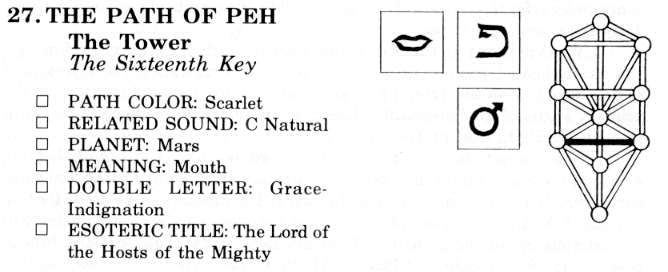
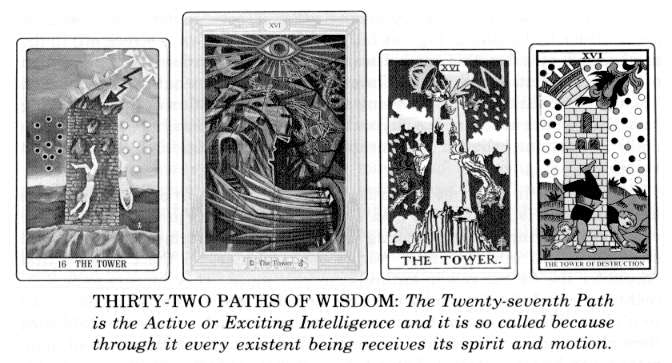

Phe or Pe is the seventeenth in the procession of Hebrew letters; and it is also one of the double letters, having two sounds; and it is in addition one of the "finals," or letters which are written in a special way when they occur at the end of a word. There are five consonants which have these "final" significators; they are: Kaph, Mem, Nun, Phe and Tsaddi. These "finals" are not to be confused with the "doubles," which are: Beth, Gimel, Daleth, Kaph, Phe, Resh and Tau. Numerically, Phe is the significator of the number 80, which is the eighth sublimation of the decad. As there are Ten Sephiroth, so there are, in reality, ten cosmic planes upon which all of the Sephiroth manifest. The grand divisions, however, are the four given in another place: Atziluth, the World of Emanations; Briah, the World of Creation; Yetsirah, the World of Formations; and Assiah, the World of Action.
Again as numerological seventeen, Phe's place in the procession of letters, yields 8, (1 plus 7). We have shown that 8 represents the double feminine, the Feminine in Exaltation and the Feminine in Generation.
Physiologically, Phe is the pituitary gland, which when awakened points toward thought transference, intuitive knowing and other extended faculties making for a race that is "super" human. We are as yet "a little lower than the angels," but Phe intimates that which we shall be in that day when "we shall be like Him for we shall see Him as He is." Its keyword is Immortality, and its Tarot symbol is an eight-pointed Star. The seventeenth Tarot card is named "The Star," a title not conferred on any other Arcanum.
Phe, "the Star," is "the true Light that lighteth every man that cometh into the world." This is the star of the blessing which is being poured upon a transformed world and which is being assimilated by a new and transfigured humanity.
We noted in the fourteenth Tarot Arcanum a beautiful angel maiden who was conserving the sacred Elixir or Life, or the Holy Spirit essence within herself.
In the seventeenth Tarot Arcanum we find this same angelic maiden-but here she represents a higher phase of spiritual development, for having conserved this great force within herself until it has become a. truly transcendent power, she is now pouring it forth in blessing upon the world. She holds the same two vases we observed in Arcanum fourteen, but this time she is pouring forth the precious contents, one upon the sea, and the other upon the land.
Here we find the union of the two Feminines-the lower is uplifted and united with the higher. This produces a tremendous force which is cleansing, purifying, uplifting and transforming.
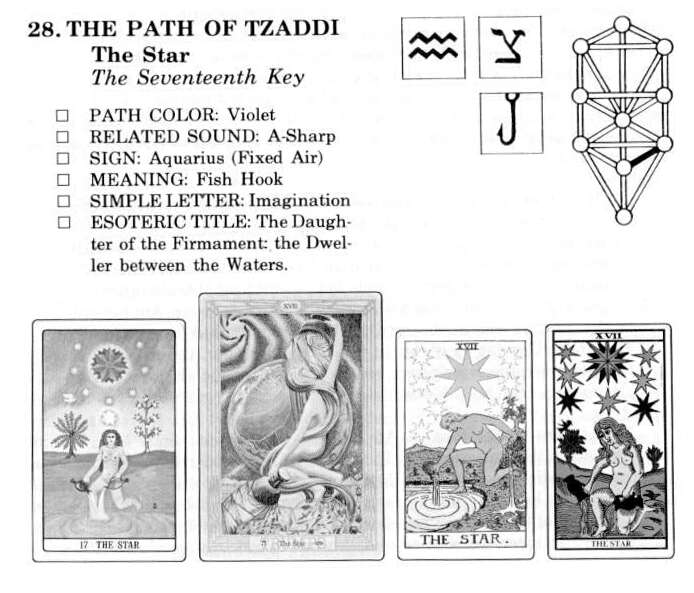

Tzaddi is the eighteenth letter of the Hebrew alphabet in order of procession. It is a single letter. Interpreted esoterically one may observe in Tzaddi the upheaval wherein earth and its humanity are engulfed at the present time. Tzaddi is a pruning hook or scythe, and it "journeys toward a final solution." Numerically it signifies 90.
Cosmically it denotes that the spiritual forces are persisting in their efforts to arouse latent spirituality in man.
The number 18 is 1 plus 8, or 9, which is also the mystic 3 x 3, indicating that inner work is being accomplished on man's three lower vehicles — mind, desire nature and body. That the work is being accomplished under the auspices of 9 proves its ultimate and complete success, for this number foreshadows accomplishment.
Tzaddi has an esoteric connection with both Teth, the ninth letter, whose name suggests the "Tet" of Osiris, and the Tau, which has the sound of T but also of S. It also connects with Schin, which has the sounds both of Sh and S.
A lone scorpion is in the center of the Tarot glyph. This symbol indicates that the beginning of the New Age will not be all good. Forces of darkness will. become more aggressive as the Good shows itself increasingly dynamic. The scorpion (sex) will be one of the great evils. After a period of libertinism, new codes of conduct will be established which are based on a higher understanding of the creative fires and their true power when uplifted and used on mentally creative planes.
Tzaddi prepares us for the highest power of Nine (9). We noted in the study of the ninth Arcanum that 9 is the number of Initiation and also of humanity. In the study of the ninth Tarot Arcanum we noted the development of Wisdom, which is the foundation of all true Initiation. In the eighteenth Tarot Arcanum we note the number 9 in its relationship to the ninth cosmic plane, for it signifies the ninth phase or plane of the decad.
The Hebrew letter Tzaddi is astrologically correlated with the Hierarchy of Aquarius whose keywords are Brotherhood and Unity. It is the eleventh of the single letters.
The eighteenth Tarot Arcanum is divided into two parts. In one part the landscape is covered with darkness, in the other it is revealed in light. Not only the landscape but also the great sun is shown half in darkness and half in light. In one of its meanings the dark side represents the Piscean Age which is now waning, and the light side the Aquarian Age which is just beginning to dawn. The Piscean Age has been a time of pain, sorrow and despair when the world has been filled with wars and rumors of wars-every nation armed to the teeth, looking with fear, suspicion and oftentimes hatred on its neighbors. The spiritual signature of the Piscean Age has been the Crucified Christ.
The Bible contains many dramatic pen pictures descriptive of the incoming New Age, among them, "There shall be no more sorrow, pain or tears, for the former things have passed away."
In the glory of the New Day all mankind will be united into one vast brotherhood whose keynote will be "The greatest good for the greatest number." The idealistic concept of life in the New Age will be centered in the beautiful teaching of the Lord Christ, "Do unto others as you would have them do unto you."
When the Aquarian Age has fully dawned mankind will have learned to overcome death which has been the greatest enemy of the Piscean Age. The spiritual signature of the New Aquaria will be the Risen Christ.
Tennyson sang truly in these words:
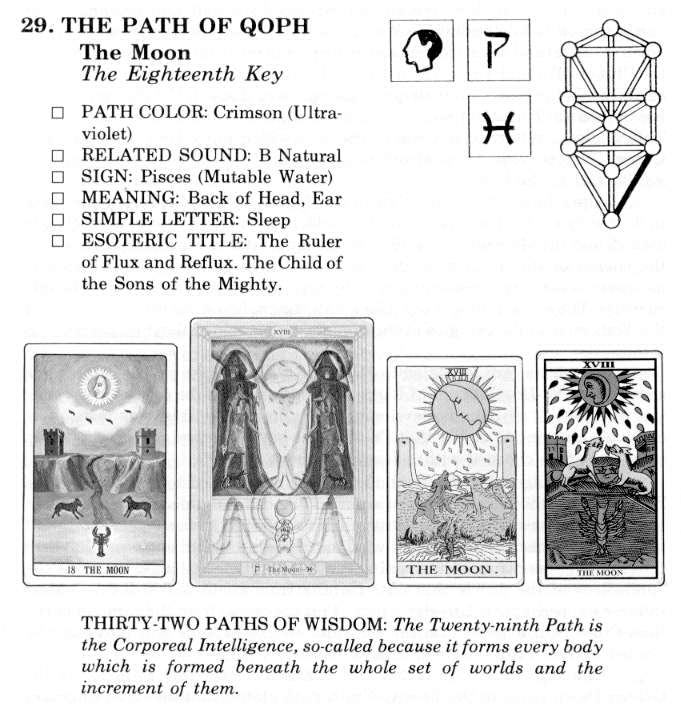

Koph or Quoph is the nineteenth letter of the Hebrew alphabet. It signifies a spiritual force directed into constructive endeavors. The twelfth of the singles, it correlates with the zodiacal sign Pisces. Numerically it signifies the number 100, and 10 x 10.
The positive and negative forces of the cosmos in their interplay surround and interpenetrate man's physical body, his mortal mind and his spirit in order to augment and accelerate their vibratory rhythms. Apollonius of Tyana, Pythagorean philosopher, said, "Until the ego becomes conscious of the two distinct currents acting within it and can thoroughly distinguish between them, it is not yet ready for initiation into the higher degrees of living."
Quoph is connected physiologically with the physical body in its entirety. The lords of Pisces aid man to immortalize his new body of light. Its keyword is Transfiguration.
The Tarot glyph shows a youth and a maiden within a walled area, symbolizing the limitations of the physical world. The sun's rays pour down upon them, and this brings to mind the Master's injunction, "Suffer little children to come unto Me." As a child is born from higher realms into the physical state, so is man's true self born from its sleep in materiality into the spiritual state.
The two children stand hand in hand (masculine and feminine in perfect balance) within a circle of flowers (spiritual awakening), while above them hangs the symbol of universal regeneration. The glory of John's vision is made plain in Quoph. It is the beginning of the new heaven and earth where there is no more pain, disease, poverty or death, and earth has been transformed into an eternal summerland. The prodigal son has returned to his Father's house and is received with rejoicing. The door swings wide upon a nobler life, whereof Christ said, "Ye must be born again." Here man enjoys perpetual youth in a state of supreme love and happiness.
Some writers have ascribed the nineteenth Arcanum to the rulership of Pisces, others to that of Gemini, and still others to Leo. This diversity of opinion is probably due to the degree of illumination with which one is dealing. The keynote of Pisces is Transfiguration. The keynote of Gemini is Equilibrium, while Leo is concerned with the accomplishment of the Great White Work. In Waite's Tarot series the nineteenth Arcanum depicts an infant seated upon a white horse, which represents the innocence and purity which must always accompany the harmonious blending of the masculine and feminine forces within man. The child seated on the white horse typifies the complete transmutation of the lower into the higher, the material into spiritual.
The inner message and meaning of the Hebrew letter Quoph, and also the nineteenth Tarot card, are centered in the harmonious blending of the masculine and feminine forces within the body, a blending known in all Mystery Schools as the Mystic Marriage Rite.
Nowhere in mystical literature has this Rite been more exquisitely described than in the story of King Solomon and the beautiful Queen of Sheba. Solomon was the wisest man of the Old Testament Dispensation. He was also the highest Initiate of his time. The word Solomon means The Wisdom of the Sun. The word Sheba means Seven, which has reference to the seven mystical degrees of the Temple teachings. These are:
Solomon spent three years preparing for the coming of the Queen of Sheba. This refers to the three degrees preparatory to entering the Path of Initiation.
As Solomon awaited the Queen's coming he built two great walls which extended from the border of Israel to the gates of Jerusalem (the City of Peace). One of those walls was built of gold (the masculine power), the other of silver (the feminine power), and between the two he fashioned a great lake in which were mirrored all the beauties and wonders of the world. Attired in regal garments Solomon stood upon this lake to greet the beautiful Queen. The lake symbolizes the Akashic Records wherein are mirrored all important events which have occurred upon this earth plane. It is here that in certain degrees the Initiate is permitted to read the record of his long past incarnational cycles.
The Queen arrived, robed in golden gossamer, adorned with the beautiful sevenfold colors of the rainbow. Both Solomon and Sheba are clothed in their wedding raiment, which must be fashioned by the Initiate before the Mystic Marriage Rite can be observed.
Sheba brought to Solomon priceless gifts in rare jewels of pearls and moon stones- feminine jewels which represent the beauty and holiness of the high feminine which Sheba symbolizes.
Solomon's gifts to Sheba were eight green rose trees from the mystic land of Damascus (green being the color of eternal life) and rare jars of healing waters from the magic Pool of Siloam. The body of the Initiate is often referred to as a "flower body." One possessing this body also has the ability to heal, as the Christ demonstrated many years later when he taught His disciples how to free others from blindness and obsession in the mystic waters of the Pool of Siloam.
The beautiful Marriage Song written to commemorate this high mystic rite is known as the Song of Solomon. This is not a sensuous love song, as so long believed, but is an Hallelujah ("Praise God") of rejoicing, and strikes the highest spiritual keynote of the entire Old Testament.
The coming of Solomon represents the the beginning of the Quest, and the arrival of the Queen the entrance into the second degree, or passage through the veil of Love.
The blending of the two poles of spirit constitutes the Mystic Marriage, such as the Marriage at Cana described by St. John, and this is the real significance of Solomon's beautiful Marriage Song. Veiled for those not ready for the quest under the likeness of a vividly beautiful love song, the Song of Solomon is to the illumined a revelation from the very Holy of Holies, wherein he stands face to face with the Light Eternal, now no longer seen "as through a glass darkly," but with transcendent clearness.
In some of the verses King Solomon sings to his beloved, while in others the loved one sings to him. In this antiphonic arrangement is indicated the interaction of the two poles of spirit which express as Will (Epigenesis) and Imagination (the image-building faculty) whose interaction brings new creations into being.
Solomon in his matchless song refers in many ways and through many symbols to this blending of the two poles of spirit, this great Balance achieved interiorly, which is also the theme of the Zohar.
At the time of the separation of the sexes, the masculine aura partook of the golden glory of the Sun and the feminine of the silvery beauty of the Moon. King Solomon unites them again in the body of the Initiate, which he calls the raiment of his beloved, when he sings:
The Hebrew word for Nazareth means a flower, and this flower is usually referred to as the lily. Thus Jesus of Nazareth literally means "Jesus, the Flower," or "the Lily," that is, Jesus, the pure one. The body of the new race will be a flower body, beautiful and fragrant. Man's place in evolution is between the flower kingdom and the gods. Both the rose and the lily refer to the awakening of certain 'centers of spiritual power within the body of man. The rose symbolizes the positive force and the lily the negative.
"My beloved is mine and I am his; he feedeth among the lilies." (Song: 2:16.) In this lovely verse King Solomon sounds the keynote of purity, the high note achieved through chastity, conservation and transmutation. Only through regeneration can the greater and the lesser selves be reunited in the Mystic Marriage, at which time the whole being exults in the ecstatic chant, "My beloved is mine, and I am his; he feedeth among the lilies.
"If the life is attuned to God every action is set to music." Both music and color form the setting of Solomon's soul chant. It breathes the fragrance of rose gardens and the deep loveliness of midnight skies studded with the light of blue-white stars.
"My beloved is mine and I am his, and he feedeth among the lilies," constitutes the chorus or sacred mantrurn of the Song and sounds the keynote of the Fifth Degree, Unification. This, translated literally, means that when one learns to seek God as the first and supreme Reality he learns that God is seeking him with that same eager intensity, and the blending or merging of human consciousness with God-consciousness is productive of this same ecstatic note of the soul's awakening, "My beloved is mine and I am His."
At this point there is another change in the numerical alphabet. The letter Jod was the tenth, and it was used to signify the number 10. The eleventh letter, however, Kaph, signified not I I but 20, and each letter thereafter signified the tenth number, until with Koph we find that the number signified is 100. The remaining three letters, Resh, Schin and Tav, represent the numerals 200, 300, and 400. Their significance in mystical numerology still revolves around the number of their place in the procession of letters, however. Nineteen, I plus 9, gave 10, which harmonizes with the tenth cosmic phase of the decad shown in the numeral 100.
Note that although both Kaph and Koph or Quoph have the sound "k," their numerical value differs; and the letter Koph is best thought of as Q, rather than K. Kabbalists often spell the word kabbalah with a Q — Quabbalah.
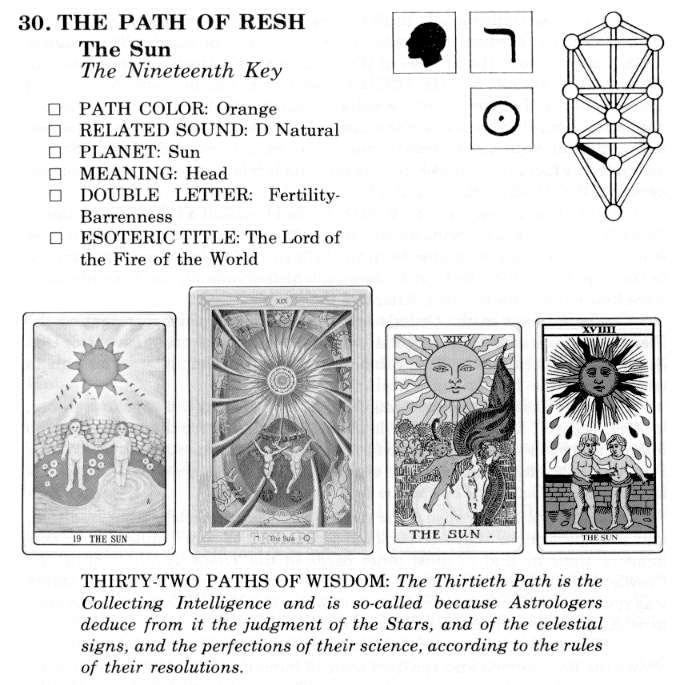
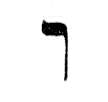
Resch, R, is the twentieth letter in the procession of letters, while numerically it signifies 200. The four letters which complete the Hebrew alphabet gather up into themselves the quintessential powers and significances of those that have gone before. According to the Zohar there are eighteen cosmic worlds, indicated by the first eighteen letter. Now we enter upon four planes which pass beyond the outer planes of matter and its limited consciousness, entering into the wide pastures of the Infinite and the Eternal.
Physiologically Resch has special reference to the pineal gland, which is the "seat" of the human spirit in occult philosophy. It stands for the ego, the thinker, and his power of creative thought or epigenesis. Epigenesis is the name for the fire of creative genius which is really latent in all beings.
Numerically Resch is 200, which reduces to 2, the number of the first manifestation of the feminine or formative principle, Beth. Its keyword is Redemption — for Resch signifies the end of the struggle for self-mastery, the culmination of the Great Work.
The Tarot glyph is an angel with wings of fire. He carries a trumpet decorated with a banner marked with a cross. This represents completion of the mystery of spirit as it is concerned with man's eventual and final unfoldment. Below the angel is an open grave from which issue forth a man, a woman and a child (symbolic of the human race). This is one of the most exquisite portrayals of the processes of Illumination and Resurrection ever given to man.
As the angel sounds the keynote of the Sun, the three figures rise from their graves (mortality). The stone of limitation (the five senses) is rolled away, freeing the spiritual consciousness for the glory of resurrection morn, as angelic hosts sing throughout the heavens, "He is risen from the dead."
Note the similarity of this glyph to the initiatory vision of St. John in Revelation, when he saw the angel clothed in the Sun descending from heaven.
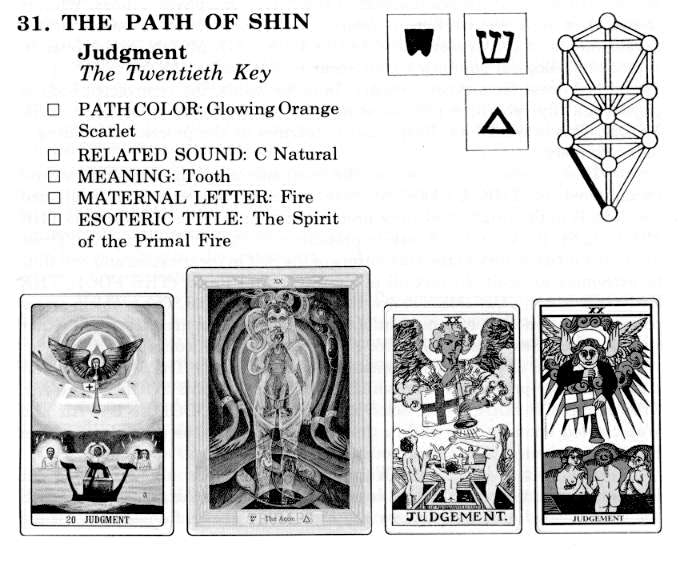

Schin is the twenty-first in the procession of letters, but numerically it signifies 300. It is a double letter, having two sounds, S and SH, and it is the last of the three mother letters — Aleph, Mem, Schin. As Aleph was Fire and Mem Water, Schin is Air. The three mother letters have been termed "the Trinity of Light." Aleph represents the head center of Light; Mem the heart center of Light; and Schin the body center of Light, the light which is vibratory power. Schin, the final letter of the third septenary, unites within itself the threefold powers of all of the three mother letters.
Schin, like the Cosmic Air which it typifies, is the power of expansion. Again it is called "the continuation of the arrow to its goal." Without this intrinsic impulse to expand, to continue, the human soul would have remained forever bound to the wheel of destiny, the karmic cycle of repeated births and deaths throughout all ages. Thus Schin represents the Christ Principle Within which is emancipation, the liberty of the Sons of God. Note that Samekh, the fifteenth letter, is a serpent-symbol; but Schin is representative of the Macrocosmic Breath, the Breath of Life, which is a "serpent" of Air, not Fire.
By the time of the Greco-Roman Period in which Jesus appeared as the Christ, mankind had become so enmeshed in karmic reactions that no human teacher could extricate him, nor could he free himself. Therefore divine intervention was necessary, and the Christ came, saying, "I am the Way, the Truth and the Life." In these words we may discover the foundation of the Christian Mysteries. When man sets his feet upon the upward path, his ability to progress and to attain is endless and without limit.
Numerically Schin, being 300, and twenty-first in the alphabet, 2 plus I or 3, reduces in both instances to 3. The Trinity is always emblematic of fulfillment or completion. Here there is no more a fallen Eve but only the Mary who is lifted up.
The Tarot glyph is a female figure in the center of an ellipse. Her legs are crossed-as are those of the hanged man for the letter Lamed-to form a cross. In the four comers of the card are the four Recording Angels of human destiny: the lion (Leo), the bull (Taurus), the eagle (Scorpio) and the man (Aquarius). These four mighty Beings release the cosmic currents of Fire, Earth, Water and Air respectively, elements of all earthly manifestation.
Man is under the protection and guidance of these vast cosmic Beings until he shall awaken and develop the Godhood within himself. This development is known in all Mystery School parlance as "the exaltation of the Divine Feminine." In this celestial state the heart becomes the body's center of creation, and love is the primal impulse of the individual life.
Beneath the central figure is that of a young girl playing a three-stringed harp, symbolic of complete harmony between spirit, mind and body. The three-toned chord sounded through Aleph, Mem and Schin is perfected in eternal harmony.
The song of Schin may be translated in the biblical words that mark the end of man's evolutionary course upon the planet earth, "Him that overcometh will I make a pillar in the temple of my God, and he shall go no more out." Earth's lessons are completed. The human cycles are finished. The egoic sheath is now the shining raiment of the Virgin Spirit. Schin denotes the final steps of Initiation.
Ancient Egyptians regarded Schin as a symbol of the universal soul. Its physiological relationship to the lower extremities refers not so much to the flesh-and-blood body as to the ethereal form:
This body is represented in the Tarot glyph by the form of the maiden surrounded by the four sacred signs.
Perfection, ideal of attainment for the human race, is the keyword of Schin.
— Corinne Heline

|

|

|
|
|
Contemporary Mystic Christianity |
|
|
This web page has been edited and/or excerpted from reference material, has been modified from its original version, and is in conformance with the web host's Members Terms & Conditions. This website is offered to the public by students of The Rosicrucian Teachings, and has no official affiliation with any organization. | Mobile Version | |
|